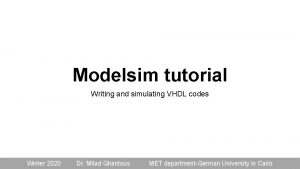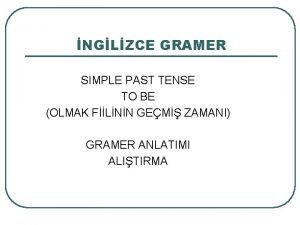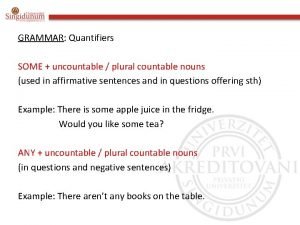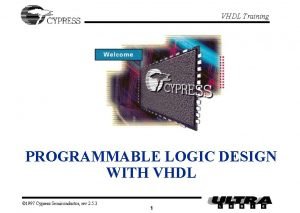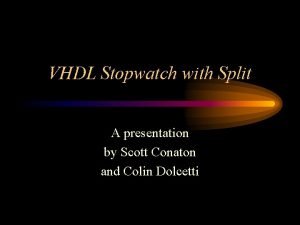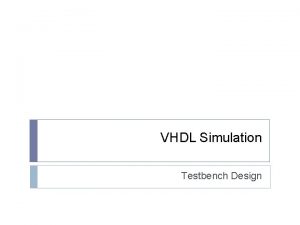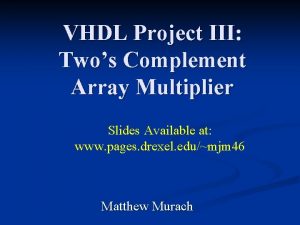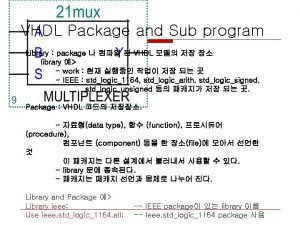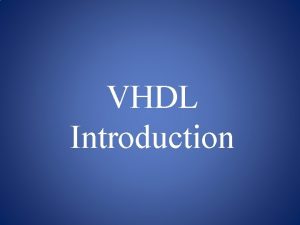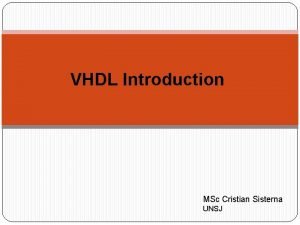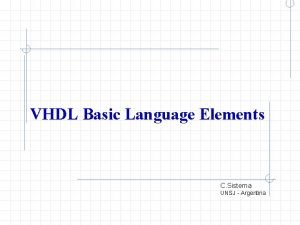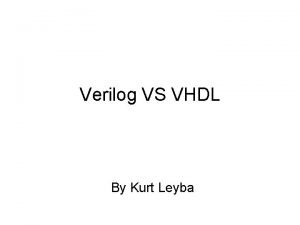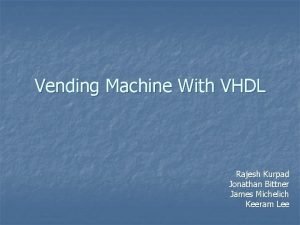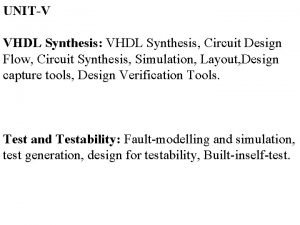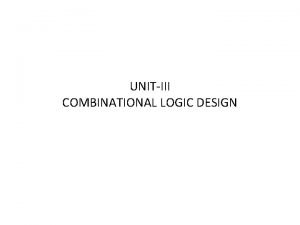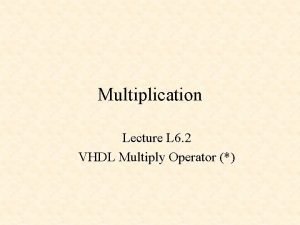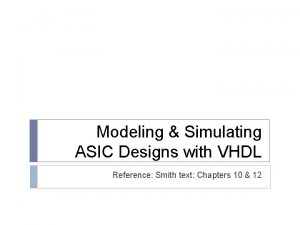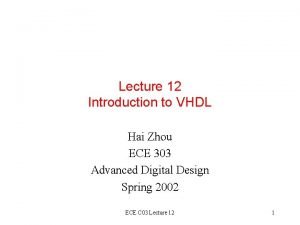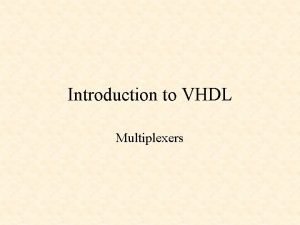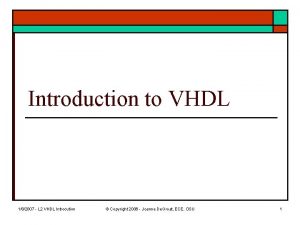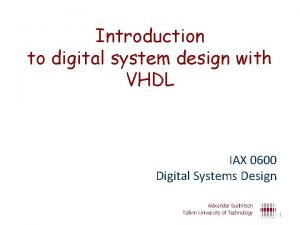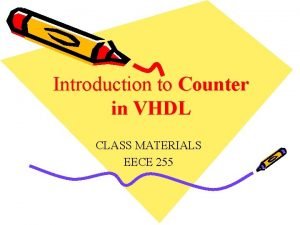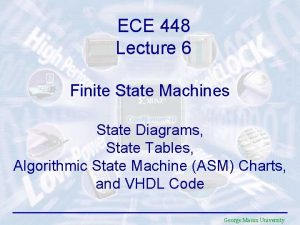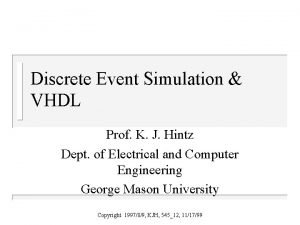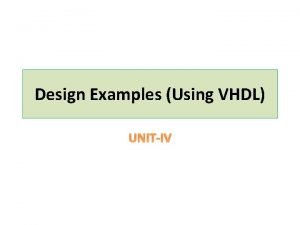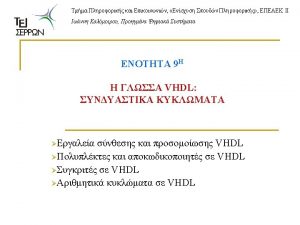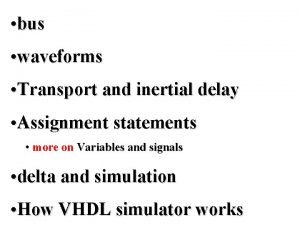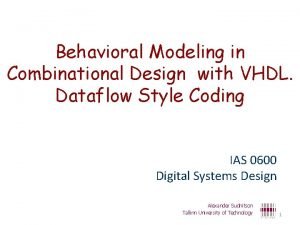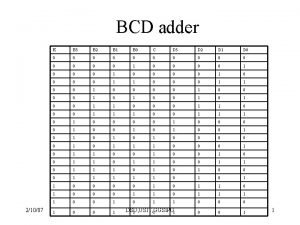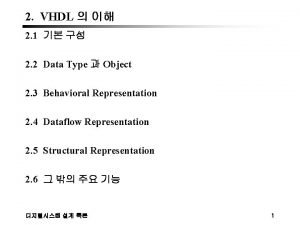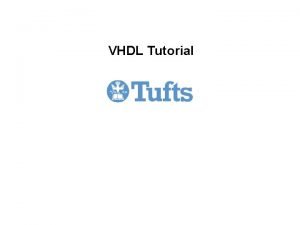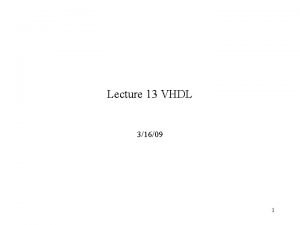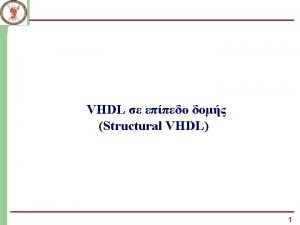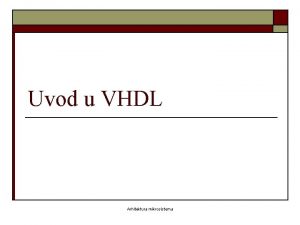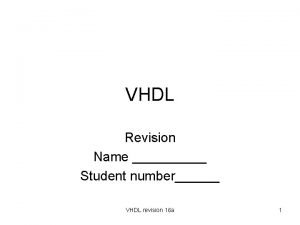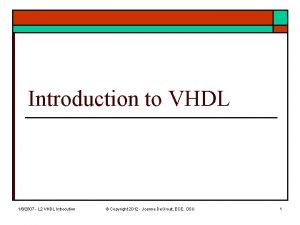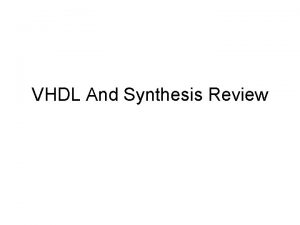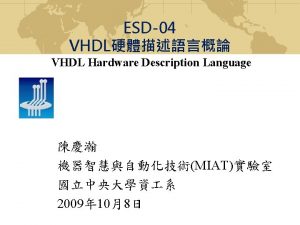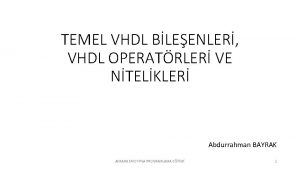VHDL Tutorial How to start VHDL Sources There
































































- Slides: 64

VHDL Tutorial

How to start VHDL, Sources? There is no need to buy any Text Book VHDL handbook (source Synplicity) http: //www. cs. umbc. edu/portal/help/VHDL-Handbook. pdf (quick ref) VHDL online tutorials http: //www. seas. upenn. edu/~ese 201/vhdl_primer. html http: //www. vhdl-online. de/tutorial/ 2

How to start VHDL, Sources? Hardware Design Platforms using HDL • ISE Design Suite (14. 7 Currently) https: //www. xilinx. com/support/download/index. html/cont ent/xilinx/en/download. Nav/design-tools. html • Vivado HL Web. PACK Edition (2018. 3 Currently) https: //www. xilinx. com/support/download. html • Intel Quartus Prime Lite Edition (18. 1 Currently) http: //fpgasoftware. intel. com/18. 1/? edition=lite • Model. Sim PE Student Edition (HDL simulator) https: //www. mentor. com/company/higher_ed/modelsimstudent-edition • 50% Xilinx, 37% Intel, 13% Others (Lattice) • Chip giant Intel has completed its $16. 7 billion mega-deal 3 to buy Altera

What does HDL stand for? HDL is short for Hardware Description Language (VHDL – VHSIC Hardware Description Language) (Very High Speed Integrated Circuit) 4

Why use an HDL? Question: How do we know that we have not made a mistake when we manually draw a schematic and connect components to implement a function? Answer: By describing the design in a high-level (=easy to understand) language, we can simulate our design before we manufacture it. This allows us to catch design errors, i. e. , that the design does not work as we thought it would. • Simulation guarantees that the design behaves as it should. 5

How do we write code? 6

Basic Form of VHDL Code • Every VHDL design description consists of at least one entity / architecture pair, or one entity with multiple architectures. • The entity section is used to declare I/O ports of the circuit. The architecture portion describes the circuit’s behavior. • A behavioral model is similar to a “black box”. • Standardized design libraries are included before entity declaration. 7

Standard Libraries § Include library ieee; before entity declaration. § ieee. std_logic_1164 defines a standard for designers to use in describing interconnection data types used in VHDL modeling. § ieee. std_logic_arith provides a set of arithmetic, conversion, comparison functions for signed, unsigned, std_ulogic, std_logic_vector. § Ieee. std_logic_unsigned provides a set of unsigned arithmetic, conversion, and comparison functions for std_logic_vector. § See all available packages at 8 http: //www. cs. umbc. edu/portal/help/VHDL/stdpkg. html

Entity Declaration • An entity declaration describes the interface of the component. Avoid using Altera’s primitive names which can be found at c: /altera/91/quartus/common/help/webhelp/master. htm# • PORT clause indicates input and output ports. • An entity can be thought of as a symbol for a component. 9

Port Declaration • PORT declaration establishes the interface of the object to the outside world. • Three parts of the PORT declaration • Name • Any identifier that is not a reserved word. • Mode • In, Out, Inout, Buffer • Data type • Any declared or predefined datatype. • Sample PORT declaration syntax: 10

Architecture Declaration • Architecture declarations describe the operation of the component. • Many architectures may exist for one entity, but only one may be active at a time. • An architecture is similar to a schematic of the component. 11

Operators ** exponentiation, numeric ** integer, result numeric absolute value, abs numeric, result numeric not complement, not logic or boolean, result same * multiplication, numeric * numeric, result numeric / division, numeric / numeric, result numeric modulo, integer mod integer, result integer remainder, integer rem integer, result integer + unary plus, - unary minus, + numeric, result numeric - numeric, result numeric + addition, numeric + numeric, result numeric - subtraction, numeric - numeric, result numeric & concatenation, array or element & array or element, result array 12 sll shift left logical, logical array sll integer, result same srl shift right logical, logical array srl integer, result same sla shift left arithmetic, logical array sla integer, result same sra shift right arithmetic, logical array sra integer, result same rol rotate left, logical array rol integer, result same ror rotate right, logical array ror integer, result same = /= < <= > >= test for equality, result is boolean test for inequality, result is boolean test for less than or equal, result is boolean test for greater than or equal, result is boolean and logical and, logical array or boolean, result is same or logical or, logical array or boolean, result is same nand logical complement of and, logical array or boolean, result is same nor logical complement of or, logical array or boolean, result is same xor logical exclusive or, logical array or boolean, result is same xnor logical complement of exclusive or, logical array or boolean, result is same

Modeling Styles • There are three modeling styles: • Behavioral (Sequential) • Data flow • Structural 13

VHDL Hierarchy 14

Sequential vs Concurrent Statements • VHDL provides two different types of execution: sequential and concurrent. • Different types of execution are useful for modeling of real hardware. • Supports various levels of abstraction. • Sequential statements view hardware from a “programmer” approach. • Concurrent statements are orderindependent and asynchronous. 15

Sequential Style 16

Data flow Style 17

Structural Style 18

Sequential Style Syntax • Assignments are executed sequentially inside processes. 19

Sequential Statements • {Signal, Variable} assignments • Flow control • if <condition> then <statments> [elsif <condition> then <statments>] else <statements> end if; • for <range> loop <statments> end loop; • while <condition> loop <statments> end loop; • case <condition> is when <value> => <statements>; when others => <statements>; • Wait on <signal> until <expression> for <time>; 20

Data Objects • There are three types of data objects: • Signals • Can be considered as wires in a schematic. • Can have current value and future values. • Variables and Constants • Used to model the behavior of a circuit. • Used in processes, procedures and functions. 21

Constant Declaration • A constant can have a single value of a given type. • A constant’s value cannot be changed during the simulation. • Constants declared at the start of an architecture can be used anywhere in the architecture. • Constants declared in a process can only be used inside the specific process. CONSTANT constant_name : type_name [ : = value]; CONSTANT rise_fall_time : TIME : = 2 ns; CONSTANT data_bus : INTEGER : = 16; 22

Variable Declaration • Variables are used for local storage of data. • Variables are generally not available to multiple components or processes. • All variable assignments take place immediately. • Variables are more convenient than signals for the storage of (temporary) data. 23

Signal Declaration • • Signals are used for communication between components. Signals are declared outside the process. Signals can be seen as real, physical signals. Some delay must be incurred in a signal assignment. 24

Signal Assignment • A key difference between variables and signals is the assignment delay. 25

Variable Assignment 26

IF – vs CASE – statement Syntax 27

FOR – vs WHILE – statement Syntax For is considered to be a combinational circuit by some synthesis tools. Thus, it cannot have a wait statement to be synthesized. While is considered to be an FSM by some synthesis tools. Thus, it needs a wait statement to be synthesized. 28

WAIT – statement Syntax • The wait statement causes the suspension of a process statement or a procedure. • wait [sensitivity_clause] [condition_clause] [timeout_clause]; • Sensitivity_clause : : = on signal_name wait on CLOCK; • Condition_clause : : = until boolean_expression wait until Clock = ‘ 1’; • Timeout_clause : : = for time_expression wait 29 for 150 ns;

Sensitivity-lists vs Wait-on - statement 30

Concurrent Process Equivalents • All concurrent statements correspond to a process equivalent. U 0: q <= a xor b after 5 ns; is short hand notation for U 0: process begin q <= a xor b after 5 ns; wait on a, b; end process; 31

Structural Style • Circuits can be described like a netlist. • Components can be customized. • Large, regular circuits can be created. 32

Structural Statements • Structural VHDL describes the arrangement and interconnection of components. • Behavioral descriptions, on the other hand, define responses to signals. • Structural descriptions can show a more concrete relation between code and physical hardware. • Structural descriptions show interconnects at any level of abstraction. 33

Structural Statements • The component instantiation is one of the building blocks of structural descriptions. • The component instantiation process requires component declarations and component instantiation statements. • Component instantiation declares the interface of the components used in the architecture. • At instantiation, only the interface is visible. 34 • The internals of the component are hidden.

Component Declaration • The component declaration declares the interface of the component to the architecture. • Necessary if the component interface is not declared elsewhere (package, library). 35

Component Instantiation • The instantiation statement maps the interface of the component to other objects in the architecture. 36

Component Instantiation Syntax • The instantiation has 3 key parts • Name • Component type • Port map 37

Component Libraries • Component declarations may be made inside packages. • Components do not have to be declared in the architecture body 38

entity ADDER is generic(n: natural : =2); port( A: in std_logic_vector(n-1 downto 0); B: in std_logic_vector(n-1 downto 0); carry: out std_logic; sum: out s Generics • Generics allow the component to be customized upon instantiation. • Generics pass information from the entity to the architecture. • Common uses of generics • Customize timing • Alter range of subtypes • Change size of arrays 39 ENTITY adder IS GENERIC(n: natural : =2); PORT( A: IN STD_LOGIC_VECTOR(n-1 DOWNTO 0); B: IN STD_LOGIC_VECTOR(n-1 DOWNTO 0); C: OUT STD_LOGIC; SUM: OUT STD_LOGIC_VECTOR(n-1 DOWNTO 0) ); END adder;

Technology Modeling • One use of generics is to alter the timing of a certain component. • It is possible to indicate a generic timing delay and then specify the exact delay at instantiation. • The example above declares the interface to a component named inv. • The propagation time for high-to-low and low-to-high transitions can be specified later. 40

Structural Statements • The GENERIC MAP is similar to the PORT MAP in that it maps specific values to generics declared in the component. 41

Generate Statement • Structural for-loops: The GENERATE statement • Some structures in digital hardware repetitive in nature. (RAM, ROM, registers, adders, multipliers, …) • VHDL provides the GENERATE statement to automatically create regular hardware. • Any VHDL concurrent statement may be included in a GENERATE statement, including another GENERATE statement. 42

Generate Statement Syntax • All objects created are similar. • The GENERATE parameter must be discrete and is undefined outside the GENERATE statement. 43

Example: Array of AND-gates 44

VHDL Data Types 45

Predefined Data Types • • • 46 bit (‘ 0’ or ‘ 1’) bit_vector (array of bits) integer real time (physical data type)

Integer • Minimum range for any implementation as defined by standard: -2, 147, 483, 647 to 2, 147, 483, 647 • Integer assignment example 47

Real • Minimum range for any implementation as defined by standard: -1. 0 E 38 to 1. 0 E 38 • Real assignment example 48

Enumerated • User defined range • Enumerated example 49

Physical • Can be user defined range • Physical type example • Time units are the only predefined physical type in VHDL. 50

Array • Used to collect one or more elements of a similar type in a single construct. • Elements can be any VHDL data type. 51

Record • Used to collect one or more elements of different types in a single construct. • Elements can be any VHDL data type. • Elements are accessed through field name. 52

Subtype • • 53 Allows for user defined constraints on a data type. May include entire range of base type. Assignments that are out of the subtype range result in error. Subtype example

Natural and Positive Integers • Integer subtypes: • Subtype Natural is integer range 0 to integer’high; • Subtype Positive is integer range 1 to integer’high; 54

Boolean, Bit and Bit_vector • type Boolean is (false, true); • type Bit is (‘ 0’, ‘ 1’); • type Bit_vector is array (integer range <>) of bit; 55

Char and String • type Char is (NUL, SOH, …, DEL); • 128 chars in VHDL’ 87 • 256 chars in VHDL’ 93 • type String is array (positive range <>) of Char; 56

IEEE Predefined data types • type Std_ulogic is (‘U’, ‘X’, ‘ 0’, ‘ 1’, ‘Z’, ‘W’, ‘L’, ‘H’, ‘-’); • • • ‘U’ -- Uninitialized ‘X’ -- Forcing unknown ‘ 0’ -- Forcing zero ‘ 1’ -- Forcing one ‘Z’ -- High impedance ‘W’ -- Weak Unknown ‘L’ -- Weak Low ‘H’ -- Weak High ‘-’ -- Don’t care • type std_logic is resolved std_ulogic; • type std_logic_vector is array (integer range <>) of std_logic; 57

Assignments • constant a: integer : = 523; • signal b: bit_vector(11 downto 0); b <= “ 000000010010”; b <= B” 0000_0001_0010”; b <= X” 012”; b <= O” 0022”; 58

Vector & Array assignments • subtype instruction: bit_vector(31 downto 0); • signal regs: array(0 to 15) of instruction; regs(2) <= regs(0) + regs(1); regs(1)(7 downto 0) <= regs(0)(11 downto 4); 59

Alias Statement • Signal instruction: bit_vector(31 downto 0); • Alias op 1: bit_vector(3 downto 0) is instruction(23 downto 20); • Alias op 2: bit_vector(3 downto 0) is instruction(19 downto 16); • Alias op 3: bit_vector(3 downto 0) is instruction(15 downto 12); • Op 1 <= “ 0000”; • Op 2 <= “ 0001”; • Op 3 <= “ 0010”; • Regs(bit 2 int(op 3)) <= regs(bit 2 int(op 1)) + regs(bit 2 int(op 2)); 60

Type Conversion (Similar Base) • Similar but not the same base type: • signal i: integer; • signal r: real; • i <= integer(r); • r <= real(i); 61

Type Conversion (Same Base) • Same base type: type a_type is array(0 to 4) of bit; signal a: a_type; signal s: bit_vector(0 to 4); a<=“ 00101” -- Error, is RHS a bit_vector or an a_type? a<=a_type’(“ 00101”); -- type qualifier a<=a_type(s); -- type conversion 62

Type Conversion (Different Base) • Different base types: Function int 2 bits(value: integer; ret_size: integer) return bit_vector; Function bits 2 int(value: bit_vector) return integer: signal i: integer; signal b: bit_vector(3 downto 0) i<=bits 2 int(b); b<=int 2 bits(i, 4); 63

Built-In Operators • Logic operators • AND, OR, NAND, NOR, XNOR (XNOR in VHDL’ 93 only!!) • Relational operators • =, /=, <, <=, >, >= • Addition operators • +, -, & • Multiplication operators • *, /, mod, rem • Miscellaneous operators • **, abs, not 64
 Print and web sources
Print and web sources Water resources importance
Water resources importance Modelsim tutorial vhdl
Modelsim tutorial vhdl Array in vhdl tutorial
Array in vhdl tutorial If you gotta start somewhere why not here
If you gotta start somewhere why not here Jump start algorithm
Jump start algorithm Tema there is there are
Tema there is there are What part of speech is open
What part of speech is open There is there are negative form
There is there are negative form There are there is
There are there is There isn't any burger
There isn't any burger There is there are
There is there are George and tamara (doesn't don't) want to see that movie
George and tamara (doesn't don't) want to see that movie Here there over there
Here there over there A any some
A any some Sustantivos en ingles contables
Sustantivos en ingles contables There is and there
There is and there There was there were ile ilgili cümleler
There was there were ile ilgili cümleler Let's practice the game
Let's practice the game There is there are
There is there are Arehay
Arehay There's and there are
There's and there are If there is no struggle there is no progress explanation
If there is no struggle there is no progress explanation Vhdl when else
Vhdl when else Vhdl clock
Vhdl clock Colin dolcetti
Colin dolcetti Vhdl modulo
Vhdl modulo Vhdl 2's complement
Vhdl 2's complement Serial adder vhdl code
Serial adder vhdl code Attribute vhdl
Attribute vhdl Disadvantages of vhdl
Disadvantages of vhdl Vhdl
Vhdl Vhdl hierarchy
Vhdl hierarchy Corso vhdl
Corso vhdl Language
Language Verilog vs vhdl
Verilog vs vhdl Testicoin
Testicoin Vhdl synthesis circuit design flow
Vhdl synthesis circuit design flow 5 to 32 decoder vhdl code
5 to 32 decoder vhdl code Std_match vhdl
Std_match vhdl Vhdl multiply
Vhdl multiply Maquina de estados vhdl
Maquina de estados vhdl Vhdl design flow
Vhdl design flow Vhdl
Vhdl Vhdl
Vhdl Vhdl multiplexer
Vhdl multiplexer Vhdl full form
Vhdl full form Introduction to digital system design
Introduction to digital system design Vhdl counter example
Vhdl counter example Vhdl finite state machine
Vhdl finite state machine Vhdl event
Vhdl event Barrel shifter vhdl
Barrel shifter vhdl Architecture structurelle vhdl
Architecture structurelle vhdl Quartus ii vhdl
Quartus ii vhdl Numarator johnson
Numarator johnson Inertial delay and transport delay
Inertial delay and transport delay Vhdl shift left
Vhdl shift left Vhdl data flow modeling
Vhdl data flow modeling Architecture behavioral of vhdl
Architecture behavioral of vhdl Bcd adder vhdl
Bcd adder vhdl 7 segment display vhdl
7 segment display vhdl Vhdl 연산자
Vhdl 연산자 Package body vhdl
Package body vhdl 4비트 비교기 vhdl
4비트 비교기 vhdl Hdl vhdl
Hdl vhdl


